An Unconventional Boat
by Horst
Werner
(click HERE
for Folding Tri study plans)
It all began when I went sailing
with my small ballasted cabin cruiser in a 5-6 Bft. wind. A knockdown,
man-over-board and the complete inability to get the boat back
into harbour without help left me so scared that I didn't dare
to go out on that boat with my wife and my baby any more.
The safer alternative would have
been a bigger boat, about 20 feet long with a weight of at least
one ton. On the other hand, I already found the hassle I had slipping
the 350 kg boat annoying. Furthermore, such a big boat doesn't
fit well to the small and partially shallow lakes in my region,
and it would eat up lots of money for marina and maintenance.
So what did I really want? A boat
that didn't exist.
- A lightweight trailer boat, ready to sail
in about 20 minutes.
- shallow draft and beaching capability
- minimum heel even in strong winds
- capacity for up to six adults (and a handful
of small kids)
- stowage for a one-week trip
- self-draining cockpit
- unsinkability and unswampability
- a small cabin for the kids, ideally big
enough to sleep two adults
- ideally, the potential to exceed hull speed
 It
was clear that only a multihull could provide the stabilty I wanted
for a light-weight trailer boat. And I think I got infected by
the multihull virus when I made experiments with my canoe converted
into an outrigger boat before buying a "real" sailboat. A catamaran
like Wharram's Tiki 21 seemed attractive, but would not offer
the comfort I had in mind and wouldn't be a real trailer boat.
As for trimarans... well there seems to be an unwritten law that
trimarans are uncomfortable racing machines with extremely slim
center hulls. It
was clear that only a multihull could provide the stabilty I wanted
for a light-weight trailer boat. And I think I got infected by
the multihull virus when I made experiments with my canoe converted
into an outrigger boat before buying a "real" sailboat. A catamaran
like Wharram's Tiki 21 seemed attractive, but would not offer
the comfort I had in mind and wouldn't be a real trailer boat.
As for trimarans... well there seems to be an unwritten law that
trimarans are uncomfortable racing machines with extremely slim
center hulls.
But what if you build something
like a cruising centreboarder with stabilizing floats? It turned
out that it would be feasible, but that a really light planing
hull would require the cockp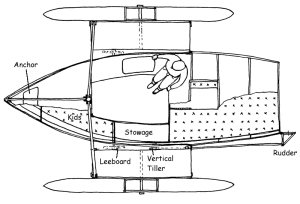 it
to be more or less in the middle, since crew weight determines
the location of the center of gravity to a high degree. On a short
boat, there would be no way of getting a reasonably sized cabin
in front of the cockpit since the first two feet are too narrow
to be of any use. So I came to the idea of having an aft cabin
and the resulting design looked like this: it
to be more or less in the middle, since crew weight determines
the location of the center of gravity to a high degree. On a short
boat, there would be no way of getting a reasonably sized cabin
in front of the cockpit since the first two feet are too narrow
to be of any use. So I came to the idea of having an aft cabin
and the resulting design looked like this:
With a hull length of 5
m and a weight of about 250 kg it was a really small boat, but
by extending the cabin under the seat bench, it would offer 2m
berths and a 1,80 m cockpit right in the middle of the boat. A
20 cm layer of styrofoam in the bottom and two drain pipes would
ensure that the boat can't be swamped or sink.
And a sophisticated folding
mechanism including floats rotating by 180° would reduce the width
from 3,50 m to 1,90 in a few minutes.
 |
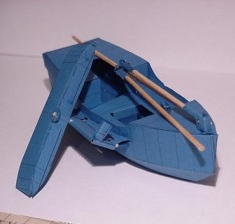 |
|
I submitted the design to Duckworks Magazine's
2000 design contest. It earned me a honourable mention (thank
you, Chuck!), but the reader's poll was, well, desillusioning.
But hey, I was the only person who needed to like it. So I
prepared myself to build my boat. |
 I bought the plywood and a used trailer in spring 2001. Unfortunately
the trailer was a bit to short for the boat, but I thought I could
get away with it if I shortened the boat to 4.70 m. At the same
time, my wife stated clearly that she would not sleep in such
a small boat, and thus the aft cabin became obsolete. I changed
the design by doing two straight cuts through the given hull lines
(my father had already made the stem and I didn't want to throw
it away): I cut off the last 30 cm and the top structures.
I bought the plywood and a used trailer in spring 2001. Unfortunately
the trailer was a bit to short for the boat, but I thought I could
get away with it if I shortened the boat to 4.70 m. At the same
time, my wife stated clearly that she would not sleep in such
a small boat, and thus the aft cabin became obsolete. I changed
the design by doing two straight cuts through the given hull lines
(my father had already made the stem and I didn't want to throw
it away): I cut off the last 30 cm and the top structures.
With the new straight deck line,
the platforms could fold 180 degrees, so the floats didn't need
a rotating mount any more. In the changed design there is still
enough space for the children under the foredeck and they can
even sleep under the aft deck.
Now the actual construction was
a very long process since my wife wouldn't let me invest all my
spare time in the boat. In fact, without the help of my father,
my brother and my sister, I would never have finished the boat
(I think my father put twice as much time into the boat as I did).
We started in summer 2001, and maybe we spent more time talking
than actually working, but it was well worth the time.
The following pictures show some
stages of the building process:
Since the hull is made from Okoume, we
glassed almost every part of the surface (they say it rots really
fast). Although I always used latex medical gloves, I finally
got allergic against epoxy. My hands appeared like cauliflower
and itched for two weeks! In March 2002, we had to get the boat
out of the workshop, which was not easy since the workshop was
in the basement. Here is how we did it:
In July 2002, the main hull was finished
and we made the maiden voyage with a trolling motor on a nearby
lake. We were six adults and three kids and we didn't feel cramped.
The main alone is already very stable and you feel safe in it.
But I didn't want a motor boat... so I went ahead. The floats
were glued together of 1m x 0,5m x 5cm styrofoam plates with a
3 cm bottom of blue foam. Then the project was waiting till April
2003, when I started taking regularly single days of vacation
in order to visit my father and work on the boat. We shaped the
floats mainly by clamping plywood templates to both sides and
then drawing a hot wire along the plywood edges. It worked very
well and only about an hour was needed to bring both floats to
the final shape with a disc sander.
We laminated them with
two layers of 200 g/m^2 glassfibre. Although I used thick rubber
gloves, protective paste and wore a gas mask, I got an allergic
reaction on the hands again. Maybe it was due to walking in the
room without gas mask after the work was done. It is really hard
to have that allergy if you're bitten by the boatbuilding bug!
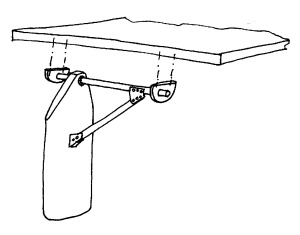 The
leeboards are very unconventional too: They hang under the platforms
and pivot around an axle made of 1" aluminium tube that runs crosswise
through their top an is glued in with epoxy. A diagonal strut
which is bolted to the leeboard just above waterline forms a triangle
together with the leeboard and the axle which can cope with the
high bending momentum. The
leeboards are very unconventional too: They hang under the platforms
and pivot around an axle made of 1" aluminium tube that runs crosswise
through their top an is glued in with epoxy. A diagonal strut
which is bolted to the leeboard just above waterline forms a triangle
together with the leeboard and the axle which can cope with the
high bending momentum.
The proper leeboard is mostly
hollow and approximates a NACA012 profile. Each is made by bending
two 5mm plywood sheets around a center strip and glueing them
to a trapezoidal "nose strip" and a triangular "tail strip". Next
time I'd take 3 or 4 mm plywood since the bending required really
high forces.

Cross section of
leeboard (and no, it's not meant to be asymmetric)
The leeboards are glassed
on the outside so that they are very strong and very light - they
must be held down in the water against their buoyancy by strong
rubber bands pulling them forward and a rigid line running aft.
The lines end has several knots and is led through a U-slot so
that its length (and thus the position of the leeboard) can be
easily adjusted.
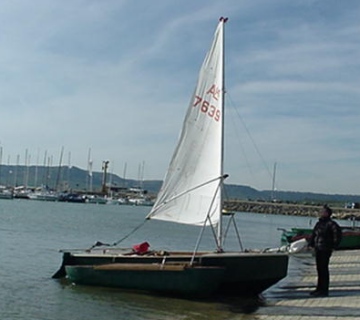
The platforms are also
sandwich structures with a 40 mm styrofoam core in a lumber frame
and two 5 mm plywood sides which are additionally glassed with
200 g/m^2 fabric. Each platform complete with the float weighs
about 25 kg. So the boat is at least 50 kg heavier than a 16'
unballasted monohull dinghy.
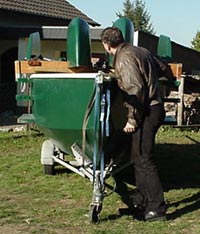 The
mast was a gift from a friend and has formerly been used on a
505 dinghy (as far as I know... with only 4,80 m it's suspiciously
short). To save time, I used the sails of a small fishing dinghy
I had a chance to buy really cheap. They fit well to the short
mast... but they have only 7.5 square meters, that is only half
the area in my plans. Well for first trials maybe not a bad idea.
To avoid jibe-caused headaches, I mounted a surfboard's sprit
boom instead of the boom belonging to the mainsail. The
mast was a gift from a friend and has formerly been used on a
505 dinghy (as far as I know... with only 4,80 m it's suspiciously
short). To save time, I used the sails of a small fishing dinghy
I had a chance to buy really cheap. They fit well to the short
mast... but they have only 7.5 square meters, that is only half
the area in my plans. Well for first trials maybe not a bad idea.
To avoid jibe-caused headaches, I mounted a surfboard's sprit
boom instead of the boom belonging to the mainsail.
The mast is stayed by two aluminium
tubes which lead lateral forces directly to the floats and two
additional galvanized steel stays which should only transmit the
forward-directed parts of the sail force.
Finally the day came when everthing
was finished and we went off for a two-day trip on a lake in France.
The boat can be folded and unfolded by one person if necessary,
but setting the mast up is easier with two persons. The whole
setup takes about 20 minutes after a bit of training.
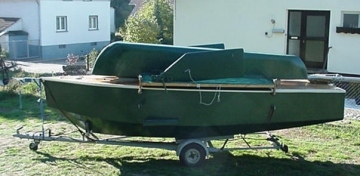
Mid of October is maybe not the best
time for such a trip, but after all that work we wanted to try
it out! It was only 11°C, but we had sun and wind. Lots of wind,
I estimate 4-5 Beaufort. The trolling motor could hardly cope
with the boat under these conditions and I felt really uncomfortable
when we set sails...
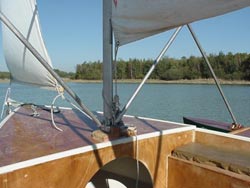 After
half an hour of completely upright sailing under full sails,
I got more confident. The boat behaves very well, it tacks on
a dime (having a boom at the foresail and the lack of necessity
to change sides makes tacking a pretty negligible manoevre)
and even when beating upwind against some nasty waves the cockpit
stays dry (apart from occasional drops). As for speed, we probably
went at hull speed most of the time but didn't get her to plane.
We'll see what happens with 15 square meters of sail. After
half an hour of completely upright sailing under full sails,
I got more confident. The boat behaves very well, it tacks on
a dime (having a boom at the foresail and the lack of necessity
to change sides makes tacking a pretty negligible manoevre)
and even when beating upwind against some nasty waves the cockpit
stays dry (apart from occasional drops). As for speed, we probably
went at hull speed most of the time but didn't get her to plane.
We'll see what happens with 15 square meters of sail.
A really useful feature is the "hawse hole"
mounted to the bowsprit. It allows to let the anchor hang from
the bowsprit all the time, with the chain in a box in the upper
part of the bow. So you don't get dirt into the boat and the
anchor can be dropped very quickly.
But still better than anchoring
is beaching! We went ashore at the lee side of an island, collected
some wood and prepared a barbecue. Maybe beaching is actually
the best part of sailing... at least when it's cold and windy.
I know that now a long phase of tinkering
with experimental sails and improving details begins. But the
boat already meets my expectations completely, I only think it
was too much work (estimated 400-500 hours). If I had to redo
the design, I'd leave out the styrofoam double bottoms, which
means having no self-draining cockpit and no self-draining stowage
boxes. With the two floats and the sandwich platforms the boat
is already unsinkable, and the only way to get water into the
cockpit is by sailing in the rain.
Im also thinking about a deck
tent that includes the foredeck and the platforms. It would offer
full standing headroom in the cockpit and allow two persons to
sleep on the platforms (which are 1,90 m x 85 cm each). Together
with a cockpit table that would mean caravan comfort on a 16 foot
boat!
(click HERE
for Folding Tri study plans)

|

